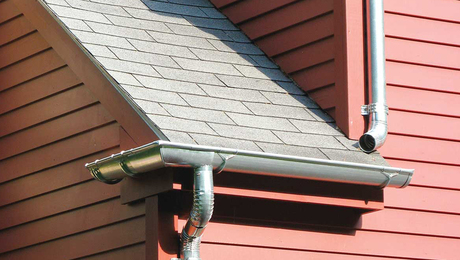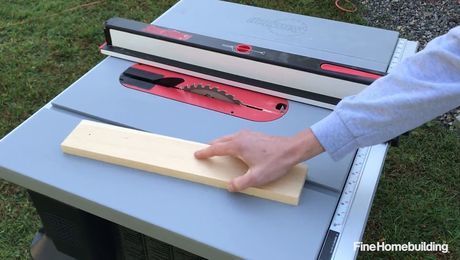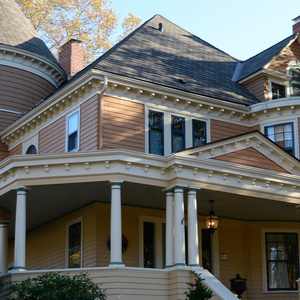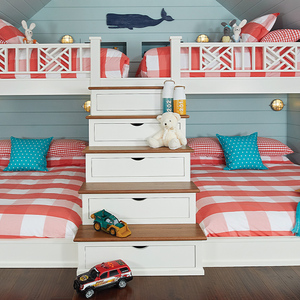How many hots can share a neutral?
Does each hot wire need it’s own neutral? It seems that split 240/120 circuits share a common neutral so could I put say 3 hots or more on one return wire?
I have a commercial building with all the lights and recepticles in the back room running on one 20amp circuit. The breaker trips fairly often, and the fire inspector doesn’t like the extension cord that somebody ran along the wall and over door frames.
There is an abandoned 240V circuit in the same run, so I have 2 more hot wires already in a junction box that I could use easily, it’s just that there is only the one neutral in the box.
Note, the abandoned circuit is on 30amp breakers and is #10 wire, so I’d have to change the breakers to 20amp to go with the #12 wire in the branch circuits.
Thanks sparky,
Goose



















Replies
Conditionaly, I will say it's ok. Run it by your local building inspectors dept and see what they say.
Samt
Commercial building, you say?
Do yourself a favor and hire a pro. Your insurance company will appreciate it. And the tenants, too.
It's one thing to learn by making mistakes on your own home, but to endanger the lives of your tenants to save a few bucks is muy mala.
Or if you want to do it yourself, get a book like Black and Deckers "Basic and Advanced Electrical Wiring" and learn about multiwire circuits.
Good luck,
Cliff
Around here, this would be a huge NO-NO. As explained to me, one neutral can serve both sides of one 240 circuit because there's no additional current on the neutral to run the second circuit; add a third hot (i.e. one side of the 240) and you've lost the balance and over-loaded the circuit.
Phill Giles
The Unionville Woodwright
Unionville, Ontario
Commercial building.
Depends. Single phase or three phase? I notice you don't specify. This is serious stuff. Commercial buildings can have either one. There are even a few places, mostly old military bases, with genuine two phase systems. If you don't know please don't mess with it.
As soon as you get into three phase you have to know how the transformer is set up, Delta or wye, and which point, if any, is grounded. You could have a high leg. Or not. Straight 120/240 three phase, fairly rare this. Or not. 120v, 208v, 277v or 480v are all fairly common branch circuit voltages in commercial and industrial work.
Nothing mysterious or mystical about it, one of the reasons I like electrical work, but you have to know what your doing. Those little electrons don't care who or what you are and are not impressed by much of anything beyond the physics of the matter. Getting it wrong can have serious consequences.
It is late. Given some details of the situation I could walk you through your options, hell I , or someone else, may have done it previously on this forum so a search and some digging might be in order.
My advice is to realize when your in over your head, preferably before you blow something up or get hurt, and call a professional. A service call is still a bargain compared to an ambulance ride, an emergency room visit or getting friendly with the fire department.
"As soon as you get into three phase you have to know how the transformer is set up, Delta or wye, and which point, if any, is grounded. You could have a high leg. Or not. Straight 120/240 three phase,"
4Lorn1,
Since I know you are one of BT's resident electricians, and know something about 3 phase wiring...Your statement there got me wondering. My [home] workshop is set-up/wired for 3 phase via a rotary phase converter. I'd have to double check, but I'm pretty sure it's fed by two 125V hots (250V) and the required ground leg.
So my questions are, Is this correct? How does 3 phase work? and why the 208V rating attached to 3 phase motors?
Jon
There many, many differe 3ph wiring systems.
It depends on what type of loads that you have.
Take a small office building. Requires lots of 120 volts for office equipment and lights. A little 3phase just for AC. That will be wired with 3 120 volt transformers in a Y pattern. The neutral is at the center of the Y. If you work out the physics the voltage from leg to leg (hot to hot) is 208.
Now take a machine shop where most of the power is required to operate 3ph equipment. Just a little bit of 120 for office eq and lights. In that case they take 3 240 transformers and connected them "end to end" in a Delta. One of the transformer is center tapped (120/240) just like on single phase service and the neutrla is at the center tap. So you have 120 volts between those two legs and neutral, but if you try to use the high leg you have 208 volts.
Now take a large store or warehouse where almost all of the power is used for lighting and AC. Just a small amount of 120 is required. Tbey use 277 volt transformers connected in Y. Lighting ballast are avialable for 277 volt. Leg to leg that 480 volts for AC or other motors. I am not sure, but in some cases I think that they use another transformer to get the 120 off of the 277.
And there are other combinations.
"And there are other combinations."
Bill,
Thanks for the info. I see there can be many combo's as the tag on the 1 HP motor of my spindle sander says 208/220/440V 3 phase. I think it draws 1.6 amps in 440 configuration.
Man, you guys start with grounding esoterica and then hit us amateurs with 3 phase!
Lord have mercy!
About 10-15 minutes into every class I've taken on 3 phase they mention that some systems can electrocute you if you just get too close. At that point my mind closes up shop and I vow to refer any 3 phase system I might run across to an electrician.
_______________________
http://www.medic37.net/prayer.shtml
Your mileage may vary ....
Can you comment on his plan to run the neutral in a different cable than his hots please (as written, he wants to use the neutral from a 120V to ALSO split a 220V)?.
Phill Giles
The Unionville Woodwright
Unionville, Ontario
That's a no, no.
The only that you can control the current in neutral is to pair with a hot (or a pair of hots in 120/240 or 3 hot in 3-phase system). But in the later cases each one of the hots is on a different leg. If you just pick up "random hot" them they might be on the same leg and will be additive, rather than subtractive on the neutral.
I'm fairly comfortable with residential wiring and it all LOOKS like what I'm used to, but you raise an interesting question about 3 ph or even 2 ph, which I don't know much about and didn't think to look. Thanks for the heads up, I'll check to be sure it's single phase.
The building is an old 1940's era Ice Cream plant turned office and retail. The service has been upgraded in stages, none of the knob and tube is functional anymore but some of the panels look like 1960's and some of the wiring is cloth covered. The old refrigeration equipment is gone but there are 3 new AC systems.
The stuff I'm looking at is modern.
Sounds like the shared neutral is OK as long as there are only 2 hots and they are out of phase.
I pulled out an old textbook and tried to apply Kirchoffs law to figure the current in the return wire - but it's been too long and I wasn't much good at it even back then. Pretty basic for a sparky, but I'm definitely mechanical minded. Always have been.
But wouldn't the voltage drop in the various devices cause the return current to be much lower? Is it fair to say the return wire is sized the same as the supply just for safety? That normally the return wire could be smaller since it carries much less current than the supply?
Thanks for the help,
Goose
Are you sure that your code allows you to work on wiring in a commercial building? Ours doesn't and it'd be a major liability issue if something went wrong...Any jackass can kick down a barn, but it takes a carpenter to build one.
I am not a sparky and you already have several professors guiding you on the theoretical and practical herding of electrons and how to rope and brand them but I'd like to ask the obvious for your consideration first.
Why were these circuits abandoned that you are hoping to light up? Could ther ahve been a nail put in the line at one time? How sure are you the wire is OK from here to there even for double use, let alone your triple.? Could be the connection was abandoned with good reason.
Like I say, I'm no sparky, but if I were the general on this job, or the owner, I would ask the sparky to be sure and hook up a meter to check and be sure that no errant calves are jumping the fence along that line. If the calves can get out, the BULL will too, and he can realy throw his weight around!.
Excellence is its own reward!
Hots sharing a neutral? I thought this was a new reality tv show where supermodels are sequestered on a desert island with a gay man.....
The frustration there would generate enough static to throw an arc and start a current, I'm sure..
Excellence is its own reward!
Piffin,
You're right, I learned more than I bargained for especially regarding multiple phases, code requirements, and so on - but that's the beauty of this forum.
I had checked out the abandoned lines visually, all nice and tidy in EMT and ending where an AC unit used to be. So I was pretty sure all was well with the wires.
It's a very old building that has had multiple lives, so it's not suprising to see different "layers" of wiring. Plus, the owner knows the history pretty well and I always check with him when something looks odd. Turns out I mis-spoke earlier - the building was originally a tin shed in 1913, then upgraded with brick walls and interior partitions around 1940. It's a travel agency office and retail space today.
So what did I end up doing? On closer inspection and thought, it was clear that all the existing light fixtures and computers were running on one hot and one neutral anyway, so I switched it all over to two hots (out of phase) and one neutral.
The breaker and wires were noticeably warm before, now they don't feel warm anymore. Not hot before, just warm.
I had to laugh a little, when I looked in the panel I counted 12 hots and only 6 neutrals, and only one double breaker. Looks like the previous guy didn't have any qualms about how many hots can share a neutral.
Anyway, it hasn't burned down yet.
GOOSE
But wouldn't the voltage drop in the various devices cause the return current to be much lower? Is it fair to say the return wire is sized the same as the supply just for safety? That normally the return wire could be smaller since it carries much less current than the supply?
No.........the loop is closed so the return current is the same. It's the voltage that has changed.
Ed
After reading a lot of posts on the subject on this site, I'll never do it.
Even though code might allow it I'm convinced it's a bad idea. You never know what someone down the road might do to the wiring that might screw it up.
If it weren't for pickpockets I'd have no sex life at all.